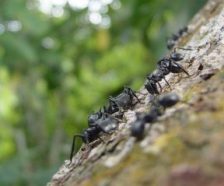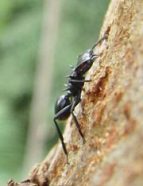Stunts for High-Diving Ants
When some tree-dwelling ants fall out of their homes, they often control the direction of their tumbles.
By Emily Sohn
Make way for a new kind of stunt-creature: ants.
Some tree-dwelling ants that live in the tropics can twist themselves in the air to change the direction of their tumbles when they fall. They end up catching on to the trunk and climbing back home. It’s like death-defying stuntwomen in movies who leap off buildings and cliffs but manage to grab onto objects to save themselves.
 |
|
When worker Cephalotes atratus ants drop from high trees, they often control the direction of their tumbles to catch on to the trunk and then climb home. |
| © Stephen P. Yanoviak |
Stephen P. Yanoviak of University of Texas Medical Branch in Galveston first noticed such maneuvers among members of the ant species called Cephalotes atratus when he was sitting high up in a tree.
A bunch of ants swarmed all over him, so Yanoviak brushed them off. As the insects fell, he noticed something interesting. Most of the ants didn’t fall straight down. In fact, they seemed to be changing their direction so they could grab back on to the tree trunk instead of hitting the ground.
So, Yanoviak brought out his video camera to make sure he wasn’t just imagining things. Because the ants are black, he painted some of them white so he could see better what was happening to them. Then, he climbed to the top of a tree and dropped thousands of the painted ants from branches about 3 meters (9 feet) away from the trunk. He filmed their falls.
After analyzing the videos, Yanoviak found that 85 percent of the dropped ants landed on the tree trunk. Some bounced off on their first try but were able to latch on farther down.
The ants seemed to be controlling their own destiny. If it had happened by chance, only about 8 percent of them would’ve hit the trunk, Yanoviak says. In fact, when he covered their eyes, that’s about how many of them reached tree trunks.
 |
|
Typically about 1 centimeter long, a Cephalotes atratus ant has long hind legs and a wide head, which may help it glide back to its home tree after dropping. |
| © Stephen P. Yanoviak |
Their wide heads and flattened rear legs seem to be the key to these amazing feats of ant tumbling, Yanoviak says. For this species in particular, being able to move around in the air seems to be a great strategy for survival.
This ant species lives in the tops of trees. Hitting the ground after a long fall wouldn’t kill the ants, but it would put them in danger of getting eaten by predators or losing their way back home, Yanoviak says. At the same time, having wings could have disadvantages, such as getting in the way of moving around in a treetop nest.
Now that scientists know what these ants can do, 007, the super-secret-agent ant, may soon be coming to a theater near you!—E. Sohn
Going Deeper:
Milius, Susan. 2005. High-diving ants swing back toward their tree. Science News for Kids 167(Feb. 12):101-102. Available at http://www.sciencenews.org/articles/20050212/fob6.asp .
You can find out more about high-diving ants and see a video of these ants in action at www.berkeley.edu/news/media/releases/2005/02/09_ants.shtml (University of California, Berkeley) and www.canopyants.com/ (Stephen P. Yanoviak).







